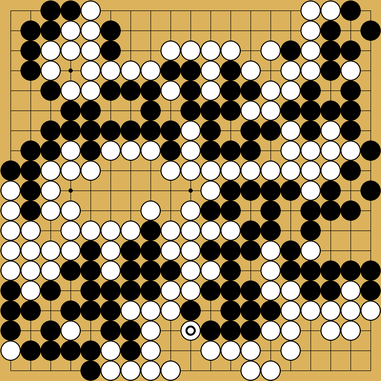I’ve put up for this for long enough, and time to continue our journey.
This is the list of the Hoensha member list in 1894, right after they revert back from pure kyu ranking to the traditional dan ranking on Apr. 1893
Compare this with the 1891 member list, we can find they are mostly the same, except they renamed and group the old 10, 11, and 12 kyu rank into “3 kyu of Shodan” (三級初段), “2 kyu of Shodan”(二級初段), and “1 kyu of Shodan” (初級初段). Effectively make all the 9 kyu to 12 kyu players “Shodan”. And instead of increasing order of “kyu”, it reverted to decreasing order of kyu within the “Shodan”.
The reason behind the decision of reverting back to the old dan system in 1893 is not well documented, but from most sources I can find they pointed to an agreement almost a decade ago at 1886 between the original head of Hoensha Murase Shuho (村瀨秀甫) and Honinbo Shuei (本因坊秀榮 the head of Honinbo house at the time). After the 9th game on Nov 15, 1885, of their ten-game matches to determine who would dominate the Go community (Murase Shuho already won 5 of the 9 games in josen 定先, always played white), Honinbo Shuei proposed to give up his Honinbo house title to Shuho, recognized the rank and diploma issued by Hoensha, and granted the title of 準名人(Jun Meijin, effectively 8d) in the name of Honinbo house to Shuho. However, Shuho also had to recognize and gave Shuei 7d diploma in the name of Honinbo house (Shuei was only 5d at the time of the match), and all the future diploma issued had to be signed by both parties (and split the fee gathered), and Hoensha had to return to the old dan ranking system (they have to sync their rank somehow).
Murase Shuho finally agreed to the term on July 30, 1886, and became the 18th head of Honinbo house - Honinbo Shuho (本因坊秀甫), and he wanted the head of Hoensha to also be the head of Honinbo house in the future, tried to cover everyone into one banner (the first attempt to a nation-wide association). But Shuho died very suddenly on Oct 14, 1886, just 2 and half months after (the shortest term as the head of Honinbo), without leaving any clear instructions as to who will be the next in line for the Honinbo house and the Hoensha.
Since it was so sudden, Shuei was again tried to push for his return as the head of the Honinbo house. But the 2nd hand of the Hoensha 中川亀三郎 (Nakagawa Kamesaburo, the first, not to be confused with his adopted son Ishii Senji 石井千治, who later on also called himself Nakagawa Kamesaburo) disagreed, and already assumed to be the head of Hoensha on Nov 1, 1886. Everything seemed to revert back to the way before the agreement (except Shuei still got his 7d recognition), and Shuei became the de facto head of the Honinbo house again. Although when Shuei issued an open challenge to everyone for his Honinbo title, Nakagawa Kamesaburo didn’t accept and just kept expanding Hoensha for more branches all over Japan and start recruiting more players from other houses and more young players through their development programs (their Insei system). The Osaka branch of the Hoensha was established in 1887, and 青年研究会 (young study group) of the Hoensha was established in 1889 (the sort of official Insei system for Hoensha).
On Mar 26, 1893, the headquarter of the Hoensha moved to a brand new building, and a ceremonial game was played between Iwasaki Kenzo (巖崎健造 the vice president and the 2nd hand of the Hoensha) and Shuei (at the time, he proclaimed to be Honinbo Shuei, but not everyone recognized it). Iwasaki Kenzo was famous for being a “thoughtful” player (he played very slow), and the ceremonial game only went for 21 moves and suspended. When the Hoensha wanted to print this game in their newspaper/magazine for the next month, they wanted to list Shuei as a Hoensha 3 kyu, but Shuei wanted to use Honinbo house ranking, and made a big deal about his old agreement with Shohu a decade earlier in 1886, and demanded they honor it.
At this point, for some reason, perhaps related to the deteriorated health of the executive Kobayashi Tetsujiro (小林鉄次郎 who was one actually running the day-to-day task), or perhaps the year earlier in 1892, Shuei started 囲碁奨励会 - the Go promoting group (became 四象会 later on), and it acted like a monthly tournament with prize money (which Yasuhisa Tamura 田村保寿 the later famous Honinbo Shusai won the 1st round, and this is like proto pro games with sponsors), and Honinbo house started to regain their fame where many strong players didn’t just play games within Hoensha, but between the Hoensha and the Honinbo house members. In any case, Hoensha seemed to finally agree on this term, and on Apr 1, 1893, the next issue of the Hoensha newspaper started to list games using the old dan ranking, with a reverted dan ranking member list shown above the next year.
I personally believe that the death of Kobayashi Tetsujir (小林鉄次郎) on Nov 7, 1893, played a major role in this. The concurrent ranking system worked fine for more than a decade, and Hoensha seemed to be at its height at this point. But the original member of Hoensha started to age and died, and Nakagawa Kamesaburo was more of a diplomat. With Kobayashi Tetsujir gone, Nakagawa Kamesaburo seemed to want to lead the Hoensha more like a traditional house.













